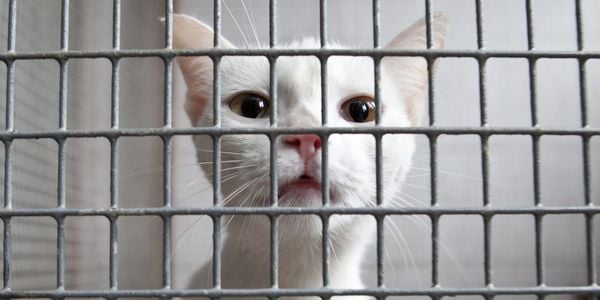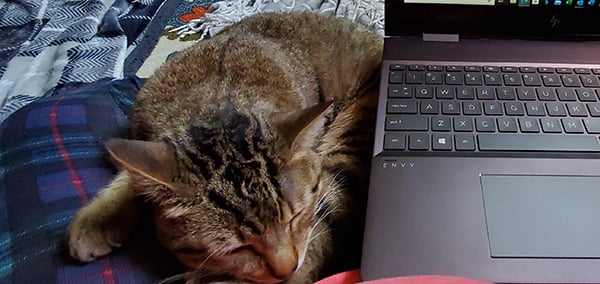
If you’re toying with the idea of becoming a cat foster (or are already so excited to foster that you can’t think straight), you’re in the right place! Foster Cats 101 is a collection of articles covering the what, why, and how of fostering fur balls. In our last article, "Why You Should Consider Fostering a Cat," we talked about why fostering is so important, how good it feels to be part of the rescue experience, and the benefits of fostering animals.
Now let's get into the most important part of the process — a deep dive into the different types of foster situations out there and understanding exactly what you have to offer. This will help you come up with a foster plan that works for you, your lifestyle, your family (human and furry), and your foster cat.
Things Potential Cat Fosters Should Consider
There are many ways to foster, each with varying degrees of time, space, and attention needed from the foster guardian. Let’s look first at the length of stay and what scenarios dictate that length.
How Long Does the Foster Cat Stay with You?
Foster stays can range from very short to indefinite. It depends on the cat's needs and how easy the cat is to adopt. For example, kittens with no medical problems are usually in high demand and are adopted out quickly. In contrast, an older cat with a treatable medical condition, like hyperthyroidism, may take more time to find a special home that is willing to take on the extra care and financial responsibility that the medical condition requires.
Short-term Foster Cats
On the shorter side, some rescue organizations have programs allowing you to foster for even just a couple of weeks. This could be a cat who has been in the rescue for a while and needs a break. Or perhaps a cat is going through a short, simple medical recovery. They might have a better recovery experience outside the rescue with some quiet and TLC.
For example, cats with mild respiratory infections don't generally act all that sick but are contagious. They might stay with a foster who can offer a quarantine space while they recover. Or perhaps a cat having dental surgery just needs a quiet place to recoup.Long-term Foster Cats
Other foster cat stays can be longer depending on the situation. Some rescue organizations allow the foster cat to stay in the foster home until they’re adopted. This is going to be more of an open-ended stay, from weeks to months. You may have new intakes who need time to be evaluated so the rescue can find the right forever home, or there may be medical issues being addressed.
Others have timelines set by the rescue organization. The rescue will ask prospective foster parents to commit to a specific amount of time, depending on the situation. At the end of that time, the cat returns to the rescue to go up for adoption. You’ll see this with young kittens who are not yet old enough to spay or neuter. Pregnant females are often sent to foster homes to give birth and stay there until the babies are weaned and spayed or neutered. Then they all return to the rescue.

Permanent and Hospice Cat Foster Situations
There are even organizations that offer permanent foster situations. An animal may be less likely to be adopted for a variety of reasons, including age or health. They move into a foster home with the understanding they may stay in that home for the rest of their lives. This is different than adoption because the rescue continues to provide supplies and medical care, which wouldn't be the case if the family adopted the animal.
Emerald City Pet Rescue is a wonderful organization that I work with, taking in animals from high-volume shelters near and far. They have a permanent foster program for animals with extensive medical or behavioral issues likely to keep them off the adoption list, and even hospice animals.
And there’s an extraordinary category of foster families who take in end-of-life foster cats, essentially helping the animal through their final days, with the support of the rescue, but in a peaceful, loving home environment. Some are adopted, but most stay with their loving foster families through the end of the cat’s life.
If you're searching for a shelter or rescue organization that focuses on particular cat needs or stages of life, such as hospice, you can narrow down your search using Petfinder.org.
What Type of Foster Cat Would Do Best with You?
The next big consideration is what type of foster would be your best match. This goes well beyond dog versus cat. (And keep in mind that you can also foster farm animals, birds, rabbits, and just about any other creature that relies on humans for help.) Here, we’re talking about the state or condition of the animal. For example:
- Healthy, no issues, just needs someplace safe and full of love until a forever home is found.
- Siblings or bonded pairs who would do best fostered together.
- Animals who absolutely can or cannot live with other animals.
- Those who need work with socialization — getting along with people, other animals, or both. This might be an animal who’s gone through a traumatic experience, a stray cat who hasn’t spent much time with people, or a former pet whose time at the rescue has left it stressed and needing to re-establish a human bond. These cases can range from simple to severe. Be sure to talk openly with your rescue organization about the level of socialization you’re comfortable taking on, so they can match you with the right animal. There’s no shame in wanting a simpler case over one that’s more intense. Love is love. They all need it.
- Age-specific. Senior cats often require a higher level of care, perhaps with medications, physical therapy, dietary needs, potty issues, etc. Very young babies who are not yet weaned and are without their mother require special care. They must be bottle-fed every few hours, groomed, need help with potty stimulation, and require close supervision. If you’d like a glimpse of this life, check out the Kitten Lady. She’s the ultimate surrogate cat mom, caring for orphaned and special needs kittens, 24 hours a day. Check out this video of hers showing the care of four-day-old foster kittens:
- Medical recovery (my area of focus), special needs, or pregnancy. Animals coming into the rescue are often in need of medical care. Some cases are straightforward and resolve quickly, like dental work, spaying, or infections. Others take more time or may need special care that’s difficult to provide in the rescue, like internal issues, amputations (my last and current fosters), repeat or multiple surgeries, or even pregnant moms who need a place to give birth and raise their babies until they’re weaned.
- Quarantine cases. This is a significant need in many rescues for two reasons:
- It’s difficult for the rescue to quarantine individual animals when they have so many in their care and simply don’t have space in their facility. Many rescues are unable to take quarantine cases at all.
- Quarantine requires a very specific foster setup. Depending on the issue, they often need a space that can be completely disinfected (hard surface floors, no soft surfaces that can't be laundered), like a spare bathroom or utility room. And obviously, they can't be near any other animals. This isn't an easy ask for most households, so the number of foster homes available for these kinds of cases is limited.
For example, ringworm in cats and dogs is entirely treatable and rarely ends in heartbreak. But it’s highly contagious. So many rescues are unable to take in animals with ringworm, and therefore, they can’t be treated. A more extreme example would be Feline Leukemia in cats. This illness is life-threatening, and quarantine is absolutely vital to protect other cats in the area.
- It’s difficult for the rescue to quarantine individual animals when they have so many in their care and simply don’t have space in their facility. Many rescues are unable to take quarantine cases at all.
What Type of Rescue Organization Should You Foster For?
Your next step is determining the type of rescue you’d like to work with. Every organization has its own process. I suggest checking out a few different rescue websites and reading up on their policies to see what best suits your needs. For example:
- If you want to work with a specific animal or situation, you can look for rescues that specialize in those. Use Petfinder's Animal Shelter and Rescue Search Tool to look up organizations near you to volunteer as a foster.
- Some rescues take animals directly off the street. Others only accept transfers from overcrowded or high-kill shelters, or cases the original rescue can’t manage.
 Some focus only on adult or senior animals, while others focus on medical cases. For example, PAWS in Washington state has a special Seniors for Seniors program, placing senior cats and dogs with people over 60.
Some focus only on adult or senior animals, while others focus on medical cases. For example, PAWS in Washington state has a special Seniors for Seniors program, placing senior cats and dogs with people over 60.
You may have seen Amanda to the Rescue on Animal Planet. That’s Amanda Giese, founder of Panda Paws Rescue in Southern Washington. Her rescue takes on medical cases and has a specific need for fosters with experience tube feeding. Babies with cleft palates or those unable to latch onto a nipple or bottle often need to be tube-fed until they’re able to eat solid food.- In my area, we have local groups who transport animals in from cities who are expecting or have gone through a natural disaster. They’ll try and clear out the shelter before the disaster hits, so those recovered after the disaster (and more likely to have families looking for them) can be kept locally. PAWS has taken in animals from Hurricane Harvey in Texas and Puerto Rico’s Hurricane Maria. Incidentally, they also have a wildlife rehabilitation program that relies on local volunteers to help return injured animals to the wild.
- Foster policies for different rescues may include restrictions on: Fostering in a rental property, fostering more than one animal at a time, or fostering from other organizations while you have one of their fosters in your care.
- The cat adoption process can also vary between rescue organizations. Some rescues allow the foster to stay in the home until an adopter is found and approved. Others prefer to keep all cats eligible for adoption on the premises. In those cases, you keep the foster until they’re ready to go up for adoption and then return them to the rescue to live until they’re adopted. Some foster families may find it difficult to send the animal back to the rescue (that’s me). Others may feel the animal has a better chance for quick adoption in the rescue. Think about it and do what’s right for you.

Be Realistic About Your Fostering Capabilities and Preferences
This is the time to be honest and realistic with yourself. Don’t be a hero. Think about what you have to offer, where you have limitations, what you can and can’t take on when fostering a cat. Fostering needs to be something you can manage along with the rest of your life. It should lift you up, not weigh you down. You don’t have to take the worst or saddest case. You need to take the case that can benefit most from what you have to offer. That’s how you stay healthy and help more cats in the long run.
Here are some things to think about, many of which perspective rescue organizations will discuss with you during the application process:
- Do you have other pets in the household?
- Do your pets get along with most animals?
- Do you prefer to keep the foster separate from your pets, regardless of how they get along?
- This dictates whether you'll foster animals who have been proven to get along with other animals. Or would you do better with an animal who likes alone time and won't mind spending time in a dedicated space?
- What is your space like?
- Do you have a space you can dedicate solely to your foster if needed?
- How big is it?
- Can it be easily disinfected?
- If you rent your home or own a condo/townhouse, are cats permitted and are there associated fees you need to consider?
- Do you have an active and noisy household, or is it calm and quiet?
- Do you have children? What ages and how will they interact with the foster?
- What breed, age, and activity level fit best in your household? Consider whether you have room for more than one cat, whether you’re able to take contagious animals if you so choose, what temperament would do best in your home, etc.
- What’s your daily schedule?
- Are you able to spend time with your foster cat throughout the day, before and after work, less during the week, and more on the weekend? This is helpful to share with the rescue so they can find a personality and activity level that fits in your lifestyle.
You may not want to foster a rambunctious kitten if you have a busy work week. But an older pet, a more relaxed personality, or a medical recovery might love a quiet room without a lot of interruption. On the other hand, if you want a cat you can snuggle and play with throughout the day, you might want to focus on well-socialized, young, and active cats. Let the rescue organization guide you. And don’t be afraid to speak up if they suggest a cat and you’re not quite sure it’s the right match. - Are you able to spend a reasonable amount of time sitting quietly with the animal or working on behavior issues?
As we speak, I’m trying to establish a bond of trust with my new foster cat, who has been very leery of me. Sitting in the room with my laptop, focusing on writing and not on him, is what prompted him to come over and lay beside me for the first time. He’s purring by my side now when just a few hours ago he was growling.
- Is your schedule flexible? Can you tag team with a partner or take your foster to work for special situations?
- Previously, I fostered a cat going through an amputation and lung issue, where I needed to be able to check on her regularly for the first few days after surgery.
- If you’re brave enough to take on orphaned kittens before they’re weaned, you’ll need feedings every few hours, day and night.
- If you take on cases with medical needs or even simple spaying and neutering, you may need to be available to take your foster to the rescue/veterinarian for care. However, many rescues will work with you on transport if needed.
- Are you home at predictable times most days?
- Helpful if you’re considering fosters with specific feeding, medication, or potty needs.
- Helpful if you’re considering fosters with specific feeding, medication, or potty needs.
- Do you live close to the rescue and their partners, or can you travel if needed?
- Depending on your situation, you might want to work with a rescue located close to your home.
- My first foster was a simple respiratory infection case who needed a week or two outside the rescue to recover. I chose to work with a rescue 90 minutes away (three hours round trip). That was fine for a simple case. But it wouldn’t be feasible for a situation that required multiple veterinary visits. It wouldn’t be good for the animal or me to be in the car for that long, on a regular basis.
- If you take on medical cases, you may find your rescue works with veterinary specialists outside their organization. In these cases, you’d likely have the option to take your foster to the specialist yourself or drop them off at the rescue, which would handle transport from there.
- Do you want to be responsible for your foster’s supplies (food, litter, etc.)?
- Most rescues cover all medical care, including medication.
- Some will supply everything you need, from food and bowls to beds and litter boxes.
- Others may provide only certain supplies.
- Most will send you and your foster home with a favorite toy and blanket, at the very least.
- Are you open to pets with potty issues?
- Don’t be afraid to say no if this isn’t for you. I did. I have floors that can be damaged and other pets who would respond badly. It’s just not a situation I want to add to my foster plan at this point. You may have a different setup or willingness. It’s whatever works for you!
- Don’t be afraid to say no if this isn’t for you. I did. I have floors that can be damaged and other pets who would respond badly. It’s just not a situation I want to add to my foster plan at this point. You may have a different setup or willingness. It’s whatever works for you!
- Depending on your situation, you might want to work with a rescue located close to your home.
 In Closing
In Closing
I hope you’ll consider opening your home to foster a cat or sharing this article with a friend. More foster homes, more animals saved, and more people feeling valued and inspired. It’s a win, win, win!
I know trying something new can be a little scary. Every foster experience is unique and has its ups and downs. But here’s what I know. Your first foster is likely to feel safer than they did at the rescue facility, feel loved and cared for like they can close their eyes and sleep without being startled awake by a kennel full of barking dogs or the anxious energy coming from other distressed animals. Maybe they’ll spend their first night in a fluffy bed. They’ll have time to heal. And most importantly, they’ll have a better chance at a successful forever home because of you. Because you were open to the experience, you let your foster cat be part of your life for a while, you accepted them for who they were, and, most importantly, you showed them love.
If you think fostering is for you, use the ideas and questions above to start building your vision for a foster experience. Be sure to check out my previous article "Why You Should Consider Fostering a Cat" to learn about the need for and benefits of becoming a foster guardian. Check out our next article in Foster Cats 101, where we’ll walk you through the application, approval, and “OMG, my first foster is coming. What do I do now?” part of the process.
Related Articles
- Foster Cats 101: Why You Should Consider Fostering a Cat
- Foster Cats 101: Applying to Be a Cat Foster Volunteer
- Foster Cats 101: Your First Foster Cat — Set Up and What to Expect
- Foster Cats 101: Caring for Your Foster Cat
- Foster Cats 101: How to Help Your Foster Cat Get Adopted
- Foster Cats 101: Saying Goodbye to Your Foster Cat
- Where to Put Your Cat After Surgery and How to Care For Them
- Your Cat in a Cone: Elizabethan Collar Desensitization
- Is It Hard to Give Your Pet a Pill? There Are Options



